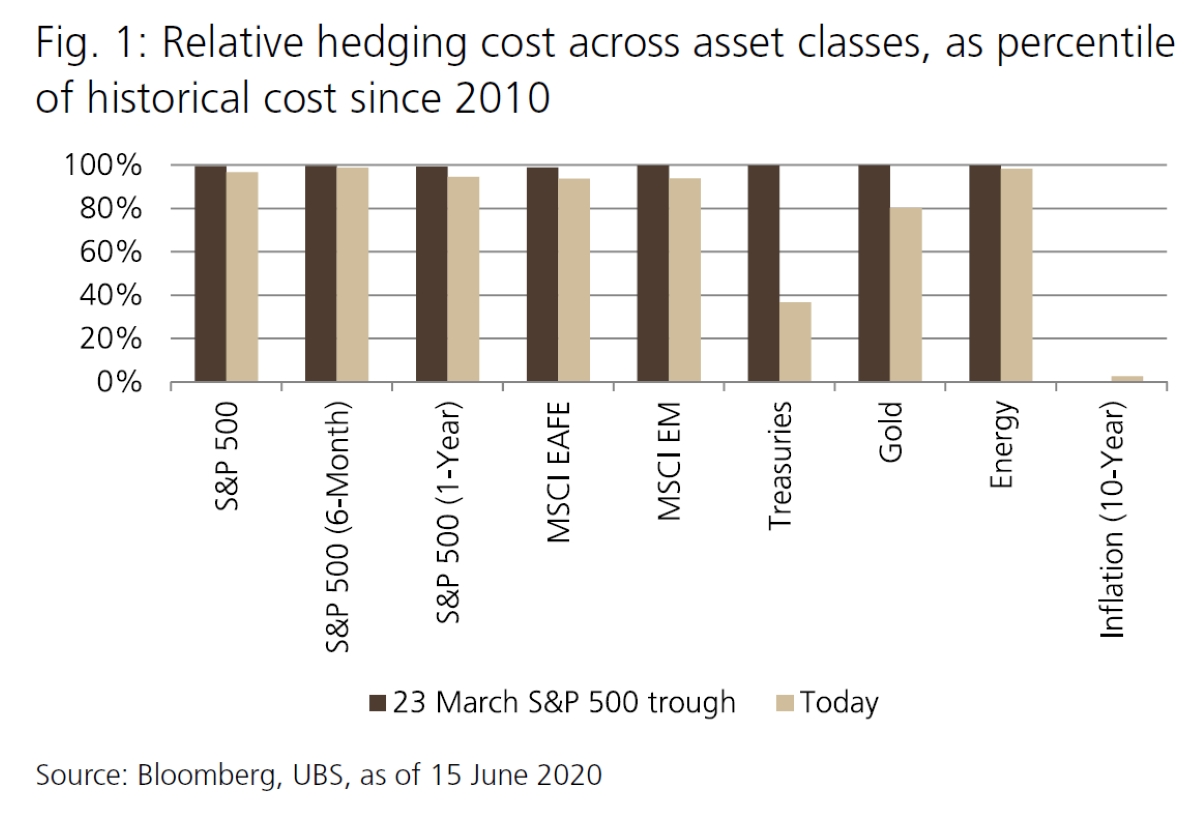

Finance
What Is A Hedging Transaction
Published: January 15, 2024
Discover the concept of hedging transactions in finance and how they can minimize risk and safeguard investments. Explore the benefits and strategies involved.
(Many of the links in this article redirect to a specific reviewed product. Your purchase of these products through affiliate links helps to generate commission for LiveWell, at no extra cost. Learn more)
Table of Contents
Introduction
In the dynamic and ever-changing world of finance, individuals and businesses face various risks that can impact their financial stability and success. One such risk is the volatility of financial markets, which can result in significant losses if not properly managed. This is where hedging transactions come into play.
A hedging transaction is a strategic financial tool used to mitigate risks associated with price fluctuations, interest rate changes, currency exchange rates, or other uncertain variables. It involves taking a position in a financial instrument that is positively correlated with the risk being hedged. In simpler terms, a hedging transaction is like an insurance policy that protects against potential losses.
The primary objective of a hedging transaction is to neutralize or offset the impact of adverse price movements or shifts in market conditions. By engaging in hedging, individuals and businesses can protect themselves against unexpected events and ensure a more stable financial position.
Hedging transactions are widely used across various sectors, including financial institutions, multinational corporations, import-export companies, and individual investors. The practice allows these entities to safeguard their investments, minimize potential losses, and maintain financial stability even in turbulent times.
This article aims to provide a comprehensive understanding of hedging transactions, their purposes, types, and the pros and cons associated with this financial strategy. Additionally, we will explore examples of hedging transactions and delve into the critical factors one must consider before engaging in such transactions.
For anyone looking to navigate the complexities of financial markets and protect their investments, a solid grasp of hedging transactions is essential. So let’s dive in and explore the fascinating world of hedging.
Definition of Hedging Transaction
A hedging transaction, also known as a hedge, refers to a financial strategy undertaken to minimize or offset potential risks arising from price fluctuations, interest rate changes, foreign exchange rate movements, or other uncertainties in the market. It involves taking a position in a financial instrument that moves inversely to the risk being hedged.
The concept of hedging can be compared to purchasing an insurance policy. Just as you buy insurance to protect your property against unexpected losses, hedging allows individuals and businesses to protect their investments and assets from adverse market movements.
Hedging transactions are designed to reduce the volatility of investment portfolios and safeguard against potential losses. By entering into a hedging position, investors can mitigate the impact of unfavorable market conditions and ensure a more predictable and stable financial outcome.
The key principle of a hedging transaction is to establish an offsetting position that acts as a counterbalance to the existing risk. For example, if an investor holds a portfolio of stocks and anticipates a decline in the overall market, they may decide to enter into a hedging transaction by purchasing put options on the stock index. This way, if the market does indeed drop, the gains from the put options would help offset the losses in the stock portfolio.
Hedging transactions can take various forms, depending on the type of risk being hedged and the financial instruments involved. Common types of hedging transactions include futures contracts, options contracts, forward contracts, and swaps. These instruments provide investors with the flexibility to manage risks related to commodities, interest rates, currencies, and more.
It is important to note that hedging transactions are different from speculation. While hedging aims to minimize risk and protect against potential losses, speculation involves taking deliberate positions in the market with the goal of maximizing profits, often without the underlying need for risk protection.
Overall, the purpose of a hedging transaction is to provide individuals and businesses with a means to manage and control their exposure to market risks. By carefully implementing hedging strategies, investors can navigate uncertain market conditions with a greater sense of security and confidence.
Purpose of Hedging Transactions
The primary purpose of hedging transactions is to minimize or offset the potential risks and uncertainties associated with price fluctuations, interest rate changes, foreign exchange rate movements, or other market variables. By engaging in hedging, individuals and businesses aim to achieve the following objectives:
- Risk Mitigation: Hedging transactions allow market participants to mitigate the impact of adverse market conditions on their financial positions. By taking offsetting positions, investors can reduce the potential losses that may result from unexpected market movements.
- Price Stabilization: Hedging transactions help stabilize prices of commodities or financial assets. For example, a wheat farmer who enters into a futures contract to sell their crop at a predetermined price is able to lock in a stable price, regardless of fluctuations in the grain market.
- Protection against Currency Risk: Businesses engaged in international trade often face currency risk due to fluctuations in exchange rates. Hedging transactions, such as forward contracts or currency options, enable companies to lock in exchange rates and protect against potential losses when dealing with foreign currencies.
- Interest Rate Management: Hedging transactions are used by entities with exposure to interest rate fluctuations, such as banks or mortgage lenders. By engaging in interest rate swaps or futures contracts, these institutions can hedge against the risk of changing interest rates and maintain more stable cash flows.
- Portfolio Diversification: Hedging transactions offer an opportunity to diversify investment portfolios and reduce overall risk exposure. By incorporating a mix of hedging instruments, investors can achieve a balance between risk and return, enhancing the stability and resilience of their portfolios.
- Regulatory Compliance: In some cases, institutions are required to engage in hedging transactions as a means of complying with regulatory requirements. For instance, financial institutions may be mandated to hedge certain positions to manage risk and meet regulatory capital adequacy standards.
Ultimately, the purpose of hedging transactions is to provide individuals and businesses with a proactive approach to managing risk and uncertainty in financial markets. By effectively hedging their exposures, market participants can protect their investments, optimize financial outcomes, and navigate volatile market conditions with greater confidence.
Types of Hedging Transactions
Hedging transactions can take various forms, depending on the nature of the risk being hedged and the specific financial instruments used. Here are some common types of hedging transactions:
- Futures Contracts: In futures contracts, two parties agree to buy or sell an asset at a predetermined price and date in the future. These contracts allow market participants to hedge against price fluctuations by locking in the future price of the asset. For example, an airline company may enter into a futures contract to hedge against the risk of rising fuel prices.
- Options Contracts: Options contracts provide the holder with the right, but not the obligation, to buy (call option) or sell (put option) an asset at a specified price within a certain timeframe. The buyer of an option pays a premium to protect against adverse price movements. Options can be used to hedge against various risks, such as stock price fluctuations or currency exchange rate changes.
- Forward Contracts: Similar to futures contracts, forward contracts involve a binding agreement to buy or sell an asset at a predetermined price and future date. However, forward contracts are customized and traded over-the-counter (OTC), whereas futures contracts are standardized and traded on exchanges. Forward contracts are often used to hedge against currency risk by locking in the exchange rate for future transactions.
- Swaps: Swaps are agreements between two parties to exchange cash flows or liabilities based on specified conditions. Common types of swaps include interest rate swaps, currency swaps, and commodity swaps. Swaps allow market participants to hedge against interest rate risk, exchange rate fluctuations, or commodity price movements.
- Options Spreads: Options spreads involve simultaneously buying and selling multiple options contracts to create a combination of positions. This strategy allows investors to hedge against potential losses while limiting profitability. Examples of options spreads include vertical spreads, horizontal spreads, and diagonal spreads.
- Structured Products: Structured products are financial instruments created by combining multiple securities to provide customized risk and return profiles. These products can be tailored to incorporate hedging components to mitigate specific risks. Structured products can include options, futures, and other derivative instruments.
It is important to note that each type of hedging transaction has its own unique characteristics, advantages, and considerations. Market participants should carefully evaluate their risk exposures and choose the most suitable hedging instrument to effectively manage and mitigate the identified risks.
Examples of Hedging Transactions
Hedging transactions are applied in various scenarios to manage risks and protect against potential losses. Let’s explore some real-world examples of hedging transactions:
- Oil Producer Hedging: Oil producers often engage in hedging transactions to mitigate the risk of declining oil prices. By entering into futures contracts to sell their oil at a predetermined price, producers can protect their revenues and secure a minimum price for their output, even if market prices decrease.
- Import-Export Hedging: Companies involved in international trade can use hedging transactions to manage currency risk. For example, an exporter based in the United States who anticipates a strengthening of the dollar can enter into a forward contract to sell their goods in a foreign currency at a predetermined exchange rate. This helps protect against potential losses caused by unfavorable exchange rate movements.
- Interest Rate Swaps: Banks and financial institutions often use interest rate swaps to hedge against fluctuations in interest rates. For instance, a bank facing the risk of rising interest rates may enter into an interest rate swap agreement with another party whereby they swap their fixed interest rate payments for floating rate payments. By doing so, the bank can protect its net interest margin and manage its exposure to changing interest rate conditions.
- Portfolio Market Risk Hedging: Investors who want to protect their investment portfolios from general market downturns can engage in hedging strategies. This can be done by purchasing put options on stock market indices or by short-selling certain assets that are negatively correlated with the overall market. These actions help offset potential losses in the portfolio if the market experiences a decline.
- Commodity Price Hedging: Farmers and commodity producers often utilize hedging transactions to manage price volatility. For example, a corn farmer can use futures contracts to sell their corn at a predetermined price, hedging against potential drops in market prices. Similarly, mining companies may engage in hedging transactions to protect themselves against declining prices of precious metals.
- Foreign Investment Hedging: Global investors who allocate capital in different countries can face currency risk due to exchange rate fluctuations. Hedging transactions, such as currency forwards or options, can be employed to reduce the impact of exchange rate movements on investment returns and protect against potential losses caused by adverse currency exchange rate shifts.
These examples demonstrate the practical application of hedging transactions across various industries and market sectors. By employing the appropriate hedging strategies, individuals and businesses can proactively manage and mitigate risks, ensuring a more secure financial position.
Advantages of Hedging Transactions
Hedging transactions offer several advantages for individuals and businesses seeking to manage financial risks. Here are some key benefits of engaging in hedging:
- Risk Reduction: Hedging enables market participants to reduce the potential impact of adverse price movements or market fluctuations. By taking offsetting positions, investors can protect themselves against losses and limit the downside risk associated with their investments.
- Preservation of Value: Hedging transactions help preserve the value of investments and assets. By mitigating the impact of market volatility, individuals and businesses can maintain a more stable and predictable financial position, even during times of uncertainty.
- Stabilization of Cash Flows: Hedging can stabilize cash flows, especially for entities with interest rate-sensitive financial instruments or foreign currency exposures. By implementing appropriate hedging strategies, businesses can ensure a more consistent and predictable cash flow, which in turn enhances financial planning and management.
- Protection against External Shocks: Hedging transactions act as a safeguard against unexpected events or external shocks that can disrupt financial markets. By hedging against specific risks, such as commodity price fluctuations or currency exchange rate movements, businesses can mitigate the negative impact of these events, reducing vulnerability to market volatility.
- Improved Decision-Making: Hedging transactions provide individuals and businesses with more certainty about their future financial positions. This, in turn, allows for better decision-making by reducing uncertainty and improving the accuracy of financial projections and planning.
- Enhanced Risk-Return Profile: By diversifying investment portfolios and incorporating hedging strategies, investors can achieve a more balanced risk-return profile. This helps optimize risk-adjusted returns and improves the overall performance of the investment portfolio.
- Regulatory Compliance: In some cases, engaging in hedging transactions may be a requirement for regulatory compliance. Financial institutions, for example, may be obligated to hedge certain risks to meet capital adequacy standards and regulatory guidelines.
It is important to note that while hedging transactions offer numerous advantages, they are not without limitations and risks. Market conditions, transaction costs, and the effectiveness of hedging instruments can influence outcomes. Thus, individuals and businesses should carefully consider the specific circumstances and carefully assess the potential advantages before engaging in hedging transactions.
Disadvantages of Hedging Transactions
While hedging transactions can provide valuable risk management benefits, they are not without their drawbacks. Here are some disadvantages to consider before engaging in hedging:
- Costs: Hedging transactions often involve transaction costs, such as brokerage fees, option premiums, or bid-ask spreads. These costs can impact the overall profitability of the hedging strategy and should be carefully evaluated in relation to the potential benefits.
- Limiting Potential Upside: When hedging, individuals or businesses may limit their potential for gains. By taking an offsetting position to protect against losses, they may forgo the opportunity to fully capitalize on favorable market movements.
- Complexity: Hedging transactions can be complex and require a deep understanding of financial markets and instruments. The intricacy involved in selecting and managing hedging strategies may pose challenges, particularly for individuals or businesses lacking expertise or access to specialized financial advice.
- Timing Uncertainty: Determining the optimal timing for entering or exiting hedging positions can be challenging. Market conditions and price movements can be unpredictable, making it difficult to determine the most opportune moments to execute hedging transactions.
- Counterparty Risk: Some hedging transactions involve entering into agreements with counterparties, such as swaps or forward contracts. This introduces counterparty risk, as the other party may default on their contractual obligations, potentially causing financial losses.
- Ineffectiveness: Hedging transactions may not always deliver the desired protection or performance. Factors such as imperfect correlation between the hedging instrument and the underlying risk, or market conditions that differ from expectations, can render the hedging strategy ineffective.
- Opportunity Cost: Engaging in hedging transactions requires allocating resources and capital towards risk management. This may divert financial resources that could have been invested in other potentially profitable opportunities.
It is crucial for individuals and businesses to carefully consider these disadvantages and assess them in the context of their specific risk exposures and financial goals. By evaluating the costs, potential limitations, and risks associated with hedging transactions, market participants can make informed decisions and develop effective risk management strategies.
Factors to Consider before Engaging in Hedging Transactions
Before entering into hedging transactions, it is important to carefully evaluate various factors that can impact the effectiveness and suitability of the hedging strategy. Consider the following key factors:
- Risk Assessment: Conduct a thorough analysis of the specific risks that need to be hedged. Identify the potential sources of risk and assess their potential impact on your financial position. This step is crucial for determining the most appropriate hedging instruments and strategies.
- Financial Goals: Clearly define your financial goals and objectives. Consider your investment horizon, desired returns, and risk tolerance. Understanding your financial objectives will help you align your hedging strategies with your overall investment strategy.
- Market Conditions: Evaluate the current market conditions and outlook. Consider factors such as volatility, liquidity, and trend direction. These factors will influence the choice of hedging instruments and the timing of entering or exiting hedging positions.
- Expertise and Resources: Assess your level of knowledge and expertise in hedging transactions. Evaluate whether you have the necessary skills and resources to implement and manage the hedging strategy effectively. Consider seeking professional advice if needed.
- Transaction Costs: Take into account the transaction costs associated with hedging transactions. Consider the impact of brokerage fees, option premiums, bid-ask spreads, and other expenses on the overall performance and profitability of the hedging strategy.
- Exit Strategy: Plan for your exit strategy before entering into a hedging transaction. Consider how and when you will unwind your hedging positions. This is important to ensure a smooth transition and avoid potential losses or disruptions when closing out the hedge.
- Monitoring and Review: Regularly monitor and review the performance of your hedging strategy. Assess its effectiveness and make adjustments if necessary. Financial markets and risk exposures can evolve over time, so it is essential to adapt your hedging strategy accordingly.
By carefully considering these factors, individuals and businesses can make informed decisions when engaging in hedging transactions. It is important to strike the right balance between risk management objectives, financial goals, and practical considerations to maximize the effectiveness and efficiency of the hedging strategy.
Conclusion
Hedging transactions play a crucial role in managing financial risks and uncertainties. They offer individuals and businesses a means to mitigate the potential impact of adverse market conditions, protect their investments, and maintain a more stable financial position. By utilizing various hedging instruments such as futures contracts, options, swaps, and forwards, market participants can hedge against price fluctuations, interest rate changes, currency exchange rate movements, and more.
While there are advantages to engaging in hedging transactions, it is important to consider the potential disadvantages, including costs, potential limitation of upside gains, complexity, and timing uncertainty. Each hedging strategy should be carefully evaluated based on specific risk exposures, financial goals, expertise, and market conditions.
Ultimately, the decision to engage in hedging transactions should align with an individual’s or business’s risk tolerance, financial objectives, and risk management strategy. Careful consideration of factors such as risk assessment, market conditions, transaction costs, and expertise can help in developing effective hedging strategies.
Hedging transactions are not a one-size-fits-all solution, and their success depends on accurate risk assessment, appropriate instrument selection, strategic timing, and ongoing monitoring. It is essential to regularly review and adapt hedging strategies as market conditions evolve.
By understanding the purpose, types, advantages, and disadvantages of hedging transactions, individuals and businesses can make informed decisions to protect their investments, enhance financial stability, and confidently navigate the dynamic world of finance.














